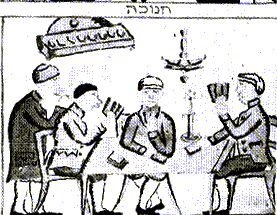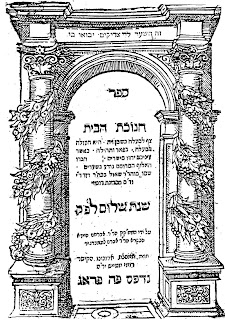The Name Machabee
One should not mistake the understanding of the proper etymology and spelling is merely an academic exercise, we begin with a statement of the Hatam Sofer. The Hatam Sofer is discussing the issue of the appropriate place for appellations in a divorce document. That is, where does one put "shlita" or the like – immediately after the person's name but before the father's name, i.e. Shimon Shlita ben Yosef, or after the father's name Shimon ben Yosef Shlita. Hatam Sofer attempts to show that the former is correct by appealing to the name Machabee. According to some, the name Machabee is an abbreviation for "Matisyahu Kohen ben Yochanon." Thus, the Hatam Sofer argues, demonstrates that the appellation, in this case "Kohen" appears immediately after the name and not at the end. Ultimately, Hatam Sofer concedes that Machabee is not a perfect proof in so far as the reason for the placement of Kohen immediately following a name is because if placed solely at the end one may assume that the Kohen only applies to the father, who, engaged in an illicit relationship rendering his son a halal one who is no longer a kohen. Thus, Machabee doesn't help for the general question of appellation placements.
However, R. Y.S. Spiegel in an series of articles discussing ראשי תיבות analyzes this Hatam Sofer and points out that the Hatam Sofer's understanding is predicated on a reading of מכבי and not מקבי. But, as Spiegel explains, מקבי has some support. And, as we will discuss below, the entire basis of the word is Greek it is especially difficult to use the word, irrespective of its spelling for much of anything.
Before preceding further, we should briefly discuss where the name Machabee first appears. It does not appear in classic Rabbinic literature such as the Mishna or Talmud. Indeed, nor can one point to the name of the book entitled Machabee and has four volumes, i.e. Machabees I, Machabees II and so forth, as has been shown, the title of these books were given much later than their composition. In fact, the title was most probably given by early Christian editors/translators of the Bible. (See generally, Uriel Rappaprot, The First Book of Maccabees, Yad Ben-Zvi, Jerusalem, 2004, pp. 12-13). Instead, the most likely candidate for the original title was סרבת סרבניאל or סרבני-אל.
The first appearance of the word Machabee does appear in the work bearing the title Machabees I. In particular, it states: In those days arose Mattathias the son of John, the son of Simeon, a priest of the sons of Joarib, from Jerusalem, and dwelt in Modin. And he had five sons, Joannan, called Caddis. Simon, called Thassi. Judas, who was called Maccabeus. Eliezer, call Avaran, and Jonathan, whose surmane was Apphus.
Machabees I, chapter 2, verses 1-5. One of the earliest persons to deal with the meaning of the word Machabee was R. Azariah Di Rossi, in his Me'or Eynaim. According to Samotheus, "Maccabee" is a Greek word that is translated as paladino (fighter) in Italian. But I have been told by others that he received the designation Maccabee because it was inscribed on his banner and derived from the acrostic based on the words Mi Kamokha Ba-elim Hashem. But this interpretation is not consistent with the fact that On the Maccabees is the title Josephus gave to the work in which he describes the sufferings of Eleazar and Hannah and her seven sons, and this episode predated the rise of Hasmonean dynasty. But the first explanation would fit, since they, too, [i.e. Eleazar and Hannah who suffered martyrdom] were also fighters. Me'or Eynaim, Imrei Binah, section two, chapter 21. Now, Weinberg, in her translation which the above was taken from with one minor alteration, explains that Somatheus is Johannes Lucidus Samotheus and this appears in his Opusculum, bk. 2, ch. 10, 25v. Di Rossi accepted Samotheus' explanation that Machabee means fighter and is a Greek word. Although not discussed by Di Rossi, Greek origin of the word makes sense in light of the fact that it was not only Judah who had a title, but his other brothers as well and those titles are Greek. Returning to Di Rossi, Di Rossi rejects the other explanation that Machabee is an acrostic because it was applied by Josephus to a story that long pre-dated Judah's existence. It is worth noting that the second and rejected explanation is perhaps the more well known explanation of the word, Weinberg in her translation, however, admits that "I do not know the source for this explanation." p. 343 n.12. This rather surprising as the source for this understanding of Machabee appears in numerous sources, including the Rokeach (Pirush Siddur ha-Teffilah le-Rokeach, Jerusalem 1992, 219 & n.105), Tzoror ha-Meor (Parshat Veshahan), Shelah as well as many others. It is unclear why Weinberg was unable to locate any of these sources.
Although Di Rossi had a good reason for rejecting the Mi Kamokha explanation, it didn't stop some from holding on to it. R. David Ganz, in his Tzemach David, argues that perhaps while Judah was the main person to use Machabee, the term may have been applied to earlier persons as well. Levin, in his Mi-Boker ad Erev, rejects this. Levin states, "with all respect to R. David Ganz, however, does this make any logical sense? In general, is it possible to prove that the son of Matisyahu was called "Judah Mi Kamokha Ba-elim Hashem" and even if one is to assume that this was his slogan? Further, if one is going to argue that Machabee is an abbreviation can't the word be explained in hundreds of different ways, for example, Mattisyahu Kohen ben Yochanan. This intrepretation, of Mattisyahu Kohen ben Yochanan, makes the least sense, as anyone with a brain will admit that it makes no sense that Judah the son of Mattisyahu's name was called "Judah Mattisyahu Kohen ben Yochanan."
A lesser known explanation was offered by Solmon Zeitlin who explained that during the Hellenistic period many people were called based upon their appearances. For example, Antichos VIII referred to Grippas as "the nose" due to his large nose. Zeitlin accepts that Machabee is based on makbas, a hammer and thus, in keeping with the norms Judah had a hammer shaped head – a block head. Thus, Judah was Judah the Hammer Head.
Levin, cites other explanations including that if makbas means a hammer it is not a large hammer but instead a small one used by a blacksmith. According to this explanation, Machabee refers to Judah's occupation a blacksmith. Indeed, if one looks to the story of Yael, she used a makabas which assuming she was of normal strength was probably not a huge hammer but a small one. Ultimately, Levin rejects this. Levin also rejects Munks explanation that Machabee refers to Hammer as used as an honorific for Charles Martel – Martel the Hammer – for his victory over the Muslims between Tours and Poitiers. Another explanation is that Machabee refers to a place – but then it should read mi-chabani.
To briefly return to the proper spelling. A bit of background. The Book of Machabees was written originally written in Hebrew but at best, the word Machabee was merely a transliteration from Greek. We no longer have the original and only have the early Greek and Latin translations which were transliterating the word. While there are essentially two schools regarding the original spelling – either with a kuf or with a chuf, that is was it spelled in Hebrew מכבי or מקבי. Of course, some of the explanations discussed above depend on how it was spelled in Hebrew. Now, I won't attempt to go through the discussion on this, but refer the interested reader to Curtis's dissertation on the topic to which we shall presently turn.
Samuel Ives Curtiss, Jr. wrote an entire dissertation on the word Machabee, The Name Machabee, Leipzig, 1876. In it, he discusses the various theories regarding the original Hebrew spelling and ultimately concludes that it was spelled מכבי. Others, however, attempt to show that the original was מקבי. I am not qualified to offer an opinion on the correctness of either. That said, Curtiss has a rather interesting and lesser known explaination regarding the etymology of the word. He argues that in the time of Judah the state of the Jews "was most pitiable. An insolent blasphemous and cruel foe filled the land, desecrated their sacred places, profanded the rite of circumcision . . . The one thought of Mattathias and his followers might well have been: How shall we extinguish these firebrands which are spreading death and desolation throughout the land." Curtis continues that the word "מכבי as a simple word there is but one probable, I might also say possible, derivation for it, and this is from כבה to be extinguished, Piel to extinguish." That is what Machabee (which would be pronounced using a kametz) means.
One final explanation and perhaps the most outrageous is that of Winkler who argues that since Machabee means hammer and hammer is used symbolically by the Greeks to refer to Gods perhaps Judah never existed and was merely a God like Zeus or Thor. Levin, rejects this as we have historical evidence that Judah existed but it is worth showing how far out the theories are.
[For additional posts regarding Chanukah see here.]
Sources:
Samuel Ives Curtiss, Jr., The Name Machabee, Leipzig, 1876
N.D. Rabinowich, Benu Shenot Dor ve-Dor, 1986, 177-186
Y. Levin, Me-Boker ad Erev, Jerusalem, 1981, 13-18
Y. Tabory, Moadei Yisroel Betekufos Hamishna Vhatalmud, 2000, 367 M. Adler, Hasmonei u-Banav, 2003, 46
Y.S. Spiegel, "Uncommon Abbreviations", Yeshurun 11 (2002) 923-24
A. Saba, Tzror Ha-Me'or, 261, stating: וזה חנוכה, לרמוז שבכח שם ה' וייחודו נצחו המלחמה, לא בחיל ולא בכח… אלא בשם ה' של הייחוד שהוא כלול בשם המפורש של ע"ב. וזהו מי כמוך באלים ה' בראשי תיבות מכב"י שעולה ע"ב. ולפי שהוא דבר סתר עושים בו ברוך כבוד ה' ממקומו (בר"ת בכי"מ (אותוית מכבי) . ולכן לפי טעם זה היו קורין לחשמונאים מכביאו"ש על שם הסוד שהיו נוצחים בכח שם השם ובכח שם המפורש של ע"ב שהוא מכב"י (פ' ואתחנן עמ' רסא) Here are a few of the books devoted to names that have recently been published:
A. Taharni, Keter Shem Tov, Jerusalem, 2000, 2 vol.
M. Rubin, Koreh Shemo, Hebron, [2002]
R. Weinberger, Tolodot Shem, Jerusalem, 2004
Y.Z. Wilhelm, Kuntres Ziv ha-Shemot, Brooklyn, 2006


